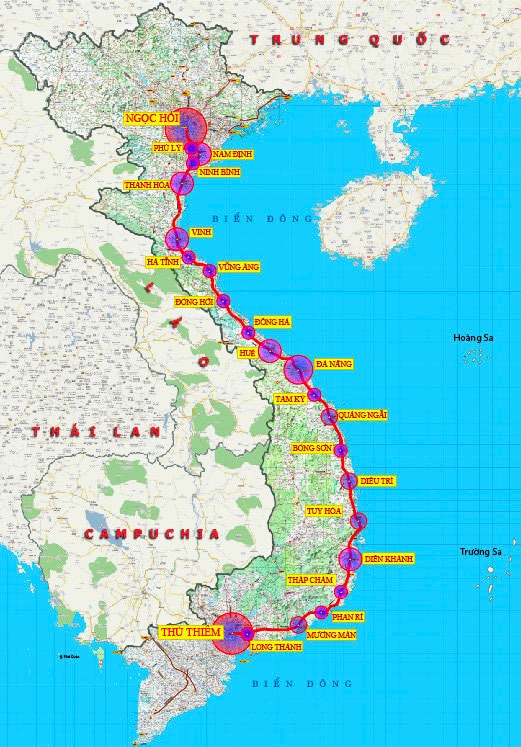The high-speed railway through Hanoi is expected to be 27 km long, with the main station in Thanh Tri district; the section through Ho Chi Minh City is 13 km long, with the main station in Thu Thiem in Thu Duc city.

According to the proposal of the TEDI-TRICC-TEDIS Consulting Joint Venture, the North-South high-speed railway line will start at Ngoc Hoi station, in Lien Ninh and Ngoc Hoi communes, Thanh Tri district, Hanoi.
From Ngoc Hoi station, the route follows the planned corridor through Thuong Tin district, to the end of Phu Xuyen district, then east to avoid Dong Van industrial park in Duy Tien district, Ha Nam province. Next, the route crosses National Highway 1, the current North-South railway, and goes east of Phap Van expressway to Phu Ly city.
Ngoc Hoi station complex includes a passenger station, a freight station and a depot for storing trains, maintaining locomotives and wagons. The depot area is planned to be located in the west of the complex. Hanoi City has planned to reserve about 250 hectares to build a fully functional national and urban terminal.
Ngoc Hoi Station has planned a complete and synchronized traffic system with 3 urban railway lines and 4 national railway lines, which will help high-speed railway passengers travel conveniently.
It is expected that by 2050, the demand for passengers at Ngoc Hoi station will be about 170,000 people per day and night, of which about 46,000 will need to go to the center (accounting for 27%), the remaining 124,000 passengers will go to other districts and provinces (accounting for 73%).
The Ministry of Transport has studied the investment in urban railway line No. 1 (Yen Vien - Ngoc Hoi), in which the national railway infrastructure and urban railway are jointly exploited. According to calculations, the mixed exploitation of high-speed railway passengers with urban railway No. 1 on this route will meet the transportation demand until 2050, provided that urban railway line No. 1 is put into operation in 2035.
In Ho Chi Minh City, the high-speed railway section running through the city is 13 km long. After crossing the Dong Nai River downstream of Long Thanh Bridge of the Ho Chi Minh City - Long Thanh - Dau Giay Expressway, the high-speed railway enters Ho Chi Minh City, expected to run through the intersections of Ring Road 3, Nguyen Duy Trinh Street, Ring Road 2, Do Xuan Hop Street, An Phu intersection to Thu Thiem Station.
Thu Thiem terminal station is located in An Phu ward, Thu Duc city, covering an area of 17.2 hectares. Long Truong depot for train maintenance and repair is planned to be located near the Long Thanh - Dau Giay expressway intersection and Ring Road 3. Ho Chi Minh City has planned to reserve 77.7 hectares to build Thu Thiem station and depot.
Regarding the plan to organize trains to the city center, Ho Chi Minh City has planned urban railway line No. 6 connecting Thu Thiem terminal station with Hoa Hung, Tan Kien terminal stations and other areas of the city to collect and relieve passengers.
In addition, the city has planned a branch route connecting Long Thanh airport with An Binh, Hoa Hung and Tan Kien terminal stations to organize passenger transport to the city center when there is sufficient demand.
Explaining the proposal that the terminal station should not be located in the center of Hanoi and Ho Chi Minh City, the TEDI-TRICC-TEDIS Consulting consortium said that in many countries, high-speed railway stations are planned according to two models: Stations in the center such as Berlin (Germany), Tokyo (Japan), Seoul (Korea). This model is convenient for passengers to access because it connects directly to the central area, taking advantage of the existing railway infrastructure, but requires synchronous planning and a large enough land fund.
The model of stations located near the center, the railway does not run through the center like Beijing (China), Paris (France) is suitable for central urban areas with limited land funds, with the ability to reserve land funds to build large-scale hub stations, creating space for urban development. However, the level of passenger access is not high.

In Hanoi and Ho Chi Minh City, the core area has been developed for a long time, but the infrastructure is not synchronized. The land fund at Hanoi station is about 14 hectares, only enough to arrange the station, train tracks, not enough land to build a square, train parking lot, and a hub station. Similarly, the land fund at Hoa Hung station is about 17 hectares, not enough to build a hub station. The road system around Hanoi station and Hoa Hung station is small, difficult to expand.
Therefore, the planning of the transport sector and the city all agree to determine the terminal stations of the North-South high-speed railway line as Ngoc Hoi and Thu Thiem.
The North-South high-speed railway project proposed by the Ministry of Transport will pass through 20 provinces and cities with a length of 1,541 km, with 23 passenger stations and 5 freight stations. The project has a total preliminary investment of 67.34 billion USD, a double-track line, 1,435 mm gauge, a design speed of 350 km/h, an operating speed of 320 km/h, and a travel time between Hanoi and Ho Chi Minh City of about 5.5 hours.
According to the calculation of the drafting agency, the expected ticket price is about 75% of the normal low-cost airfare. To suit the ability to pay and attract passengers, the ticket is divided into 3 price levels with different levels of comfort.
HQ (according to VnExpress)